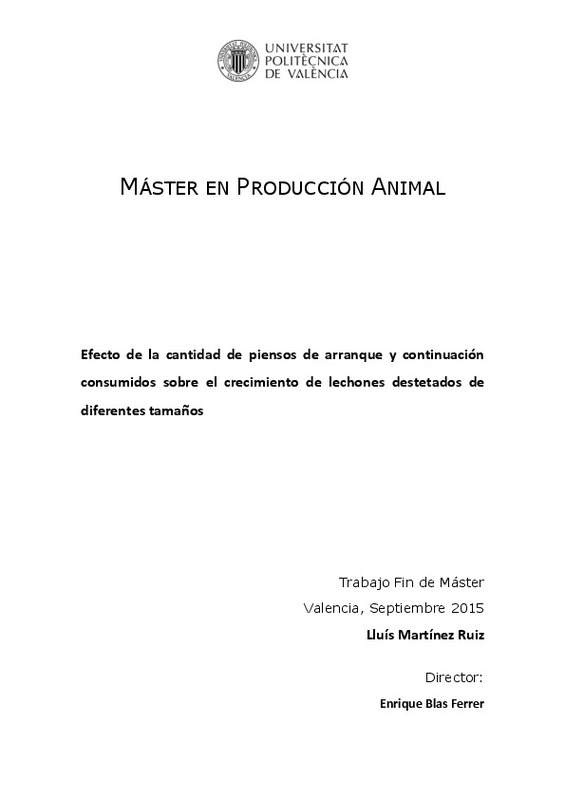|
Resumen:
|
[EN] The profitability of pig production is partly determined by the success of the transition from mother's milk to dry diets without a reduction in growth or disease incidence. The growth potential of piglets is high ...[+]
[EN] The profitability of pig production is partly determined by the success of the transition from mother's milk to dry diets without a reduction in growth or disease incidence. The growth potential of piglets is high immediately after weaning, but limited feed intake together with an immature digestive system often prevents to reach this potential under practical conditions. Piglet feeding programs in pre- and post-weaning try to alleviate this problem. Thus, the aim of this study was to determine whether increased intake of starter and continuation’s feeds (at the expense of growing feed) during the transition of piglets weaned at 21 days of life, variables depending on the weight of the piglet at weaning, affected weight gain and mortality. The results obtained indicate that increased intake of starter and continuation’s feeds: i) is not recommended in piglets with high weaning weight, since it does not increase the weight at the end of the transition but the cost food during this period, ii) improves the weight at the end of the transition in piglets with medium weaning weight and it would be interesting to assess whether this technical improvement is also economically viable, and iii) does not seem to substantially improve the weight at the end of transition in piglets with low weaning weight. Also, it has been verified that mortality during the transition is higher in piglets with low weaning weight.
[-]
[ES] La rentabilidad de la producción porcina está determinada parcialmente por el éxito de la transición de la leche de la madre a dietas secas sin que ocurra una reducción del crecimiento ni aparezcan enfermedades. El ...[+]
[ES] La rentabilidad de la producción porcina está determinada parcialmente por el éxito de la transición de la leche de la madre a dietas secas sin que ocurra una reducción del crecimiento ni aparezcan enfermedades. El potencial de crecimiento de los lechones es alto inmediatamente después del destete, pero el limitado consumo de alimento junto con un sistema digestivo inmaduro impide a menudo que se alcance este potencial en condiciones prácticas. Los programas de alimentación del lechón en pre- y post-destete pretenden aliviar este problema. En esa línea, el objetivo del presente trabajo fue comprobar si el aumento de las cantidades consumidas tanto de pienso de arranque como de pienso de continuación (en detrimento del pienso de crecimiento) durante la transición de lechones destetados a los 21 días de vida, variables en función del peso del lechón al destete, afectaba a la ganancia de peso y la mortalidad. Los resultados obtenidos permiten concluir que el aumento del consumo de los piensos de arranque y continuación: i) no es recomendable en los lechones con alto peso al destete, ya que no aumenta el peso al final de la transición y supone un incremento del coste de la alimentación durante este periodo, ii) mejora el peso al final de la transición en los lechones con peso medio al destete y, por tanto, sería interesante valorar si esta mejora técnica es económicamente viable y iii) no parece mejorar sustancialmente el peso al final de la transición en los lechones con bajo peso al destete. Asimismo, se ha podido verificar que la mortalidad durante la transición es mayor en lechones destetados con bajo peso.
[-]
|







